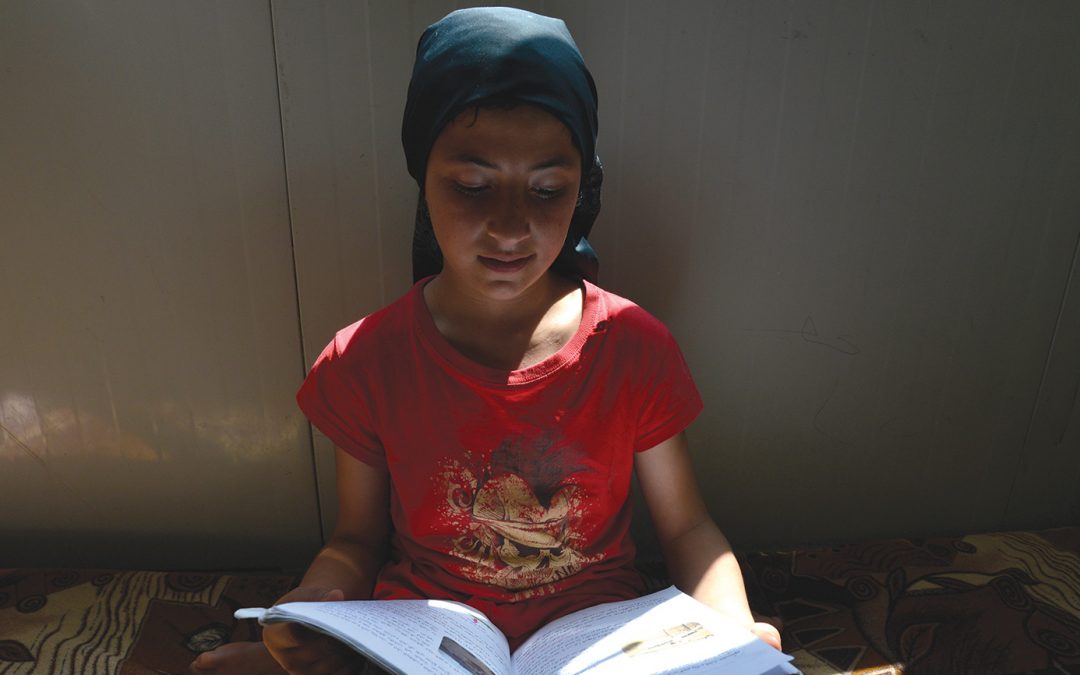This is an excerpt from UNHCR’s recently released report: Beyond Technology | Innovation at UNHCR 2015. This report highlights and showcases some of the innovative approaches the organization is taking to address complex refugee challenges.
It is easy to think about education and schools as a normal part of growing up: a bunch of children in a classroom with a teacher, textbooks, and other education supplies, with children busily learning knowledge and skills. In many refugee contexts, that’s just not the reality. Where teachers are sometimes completely untrained, where books fall apart in the heat after a few months or where girls are told they are not worth sending to secondary school, we need innovative ways to make sure that refugee children are not left behind.
After a 2011 assessment revealed refugees had very low access to education and received poor-quality education in many countries, at UNHCR we realized that we needed to change from doing the same old thing in the same old way and hoping it was going to make an impact.
We believe that it is fundamentally important for UNHCR to look at the way we are doing things and think creatively about how we can do them better. How can we truly engage young refugees in getting the knowledge and skills that will serve them well in their futures? How can we best equip teachers in some of the most resource-poor settings in the world? How can we galvanize collaborations that go beyond funding agreements to become real partnerships?
By taking an innovation approach to our work in education, we are starting to answer these questions.
For example, this year the Learn Lab, a joint venture of UNHCR Innovation and the Education Unit in the Division of International Protection, established the Connected Learning Consortium for Higher Education for Refugees, a first-of-its-kind initiative that pools resources across institutions to exponentially expand access for refugees to accredited higher education through digital learning, even in the most remote places. With 11 partners from multiple universities and organizations, 3,500 students are now enrolled and earning certificates or degrees or gaining the qualifications to serve as teachers and other professions.
New partnerships like these, and others with the Vodafone Foundation, IDEO.org, UNICEF, and DFID, allowed us to reach more refugees in 2015 with quality learning, and to learn from each other.
By thinking creatively about educational resources and access we also created Instant Network Classrooms: flexible, digital “schools in a box” that leverage mobile technology to bring connected learning to refugee children. We’ve found that students enrolled in Instant Network Classrooms actually perform better on national exams and have improved attendance and pass rates. This year, we worked with the Learn Lab to expand these Instant Network Classrooms to Kenya’s Kakuma refugee camp, and we will soon bring them to students in Tanzania, the Democratic Republic of Congo, and South Sudan.
Taking an innovative approach to the challenge of getting learning materials to refugees also led us to support the production and testing of portable multimedia centers – called Ideas Boxes – with Libraries without Borders. With computers, tablets, eBooks, paper books and internet access, the boxes are a creative way of engaging young people and the community and helping them learn and connect in a very self-directed way.
We piloted them in Burundi and the boxes are now reaching thousands: just between April and July 2015, refugees in two camps visited the boxes 21,686 times. Other partners and other countries are now setting up their own Ideas Boxes, expanding access to learning, information and culture. And these boxes are translating into real educational gains. A quantitative study completed in July 2015 showed students who attended French and Math classes within the Ideas Box showed 23 percent more academic improvement than students who took the courses in a classroom setting.
A Humanitarian Education Accelerator we launched as part of the Learn Lab in 2015 will now help us transform good pilot projects into impactful social initiatives in education. An innovative partnership with DFID and UNICEF allowed us to open up a competition for ideas with a multi-million dollar commitment for implementation over the next three years. We have announced the three winners, who will help us bring fresh approaches to re-thinking how we can create better educational access and quality.
Taking an innovative approach to how we teach, partner and expand access to education for refugees is not something we want to keep to ourselves.
Refugees will be best served when the humanitarian and development communities takes honest stock of its performance, and takes actions to improve. So, this year we established a course at the University of Geneva’s summer school that teaches students about higher education in emergencies and crises. It is starting a dialogue among UN agencies, NGOs and educators to discuss policy and programming recommendations, innovative solutions and pedagogical approaches as well as the potential role of universities as humanitarian actors.
The collaboration between DIP and the Innovation Unit to launch the Learn Lab has brought new partnership opportunities and the creative support we needed to take a good hard look at ourselves and our goals, open our minds about how to do better, and start doing it.
Right now we are focused on getting these innovative initiatives right—something we can only achieve by ensuring deep engagement from communities, partners, and young refugees themselves as we think in new ways about program design, implementation, monitoring, and eventual expansion.
We’re always looking for great stories, ideas, and opinions on innovations that are led by or create impact for refugees. If you have one to share with us send us an email at [email protected]
If you’d like to repost this article on your website, please see our reposting policy.

